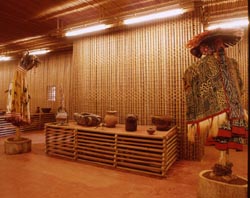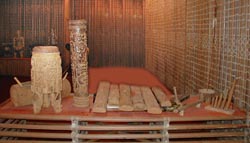
 |
|
| The Bandjoun museum | |
| Permanent exhibition | |
| Information | |
Artistic creation
Containers
|
In Bandjoun, there exists a wide variety of containers (mainly receptacles, pipes and bags), each for a specific purpose and used both for cooking and for ritual or ceremonial purposes. The receptacles are impressive by their variety of production, styles and the freedom of expression which is shown in the detail of the cut, the decoration, the weaving or the moulding. The seats belonging to the fo and the notables, or which are used in major ceremonies, have been meticulously crafted. They are decorated with geometrical or figurative patterns which are often exuberant. |
The most characteristic productions are the clay and wooden receptacles, the basketwork, the pipes, bags and above all the calabashes. The calabash rests on a sculpted support. The set is covered with a fabric on which the artist has skilfully fixed cowries or beads harmoniously creating a pattern. These objects are exhibited during ceremonies, but above all rituals and funerals. There are other varieties of calabashes such as trophy calabashes for wine. |
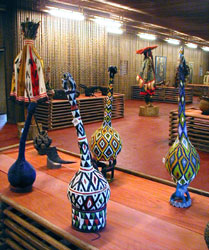 |
|
|
In Bandjoun, the display of wealth and social status through architecture is mandatory. |
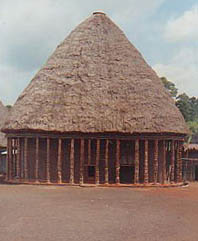 |
|
| |
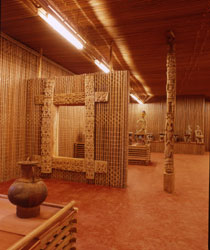 |
Since the first half of the 20 th century, there has been an evolution in autochthonous architecture. The traditional houses have gradually been replaced by modern houses (sometimes built of concrete) or buildings that combined modern and traditional elements. The very close relationship between sculpture and architecture is perfectly illustrated by the sculpted pillars and the decorated doorframes bom’dye that adorn the royal buildings, the houses of the major notables and the secret societies. They can be engraved, sculpted in bas-relief or in haut-relief and in certain cases have openwork of varying degrees. |
|
| |
Special importance is given to three categories of buildings amongst those with a symbolic or cultural interest:
The number and the nature of the decorations of the doors and pillars depend on the rank of the notable who is the owner. Today, there are concrete examples that have multiple pyramidal roofs.
|
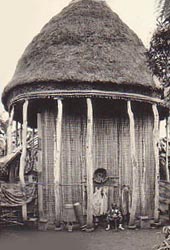 |
|
|
|
|
Apart from some zoomorphic figures, the statues and statuettes are anthropomorphic. They are generally dynamic, vigorous and expressive. In Bandjoun, the isolated figures or in the round are less plentiful than those in relief compared with the other Grassland kingdoms. |
Each category can include several types according to the forms and decorations, which depend on the degree and place in the community of the owner(s). The stools and the thrones of the monarch must be counted amongst the most important symbols of Bandjoun royalty. It is amongst the beaded examples, remarkable for this extraordinary wealth and quality of ornamentation, that some of the works of art of the Grassland are to be found. Certain pieces represent the expression of the sovereignty and of the king himself. The seats have multiple cultural and ceremonial functions in the Bandjoun community.
|
|
Musical instruments
|
Different wooden, metal and ivory musical instruments are used in leisure or in various activities of community life in Bandjoun. A good number of them, belonging to the fo, notables and secret societies, play a liturgical role or give rhythm to songs and dances with processions. Some of these objects (drums, bells etc.) with a sacred nature have been sanctified by sacrificed and magical practices. |
In this case, it is sometimes prohibited and dangerous to look at them, especially when they emit sound. Amongst these many musical instruments, the most important in the social and religious life of Bandjoun are the double bells, the flutes, the drums, sometimes richly decorated, the xylophones, the sanzas, the rattles, string instruments and horns.
The Bandjoun use both slit drums and membrane drums. The drum is an object for the cult of great importance. It convenes the meeting of the mkem, the sound and decorations evoking the indications differentiating these associations. A few dozen are used at the royal residence and in the sub-chefferies. |
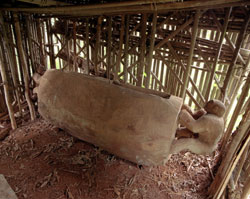 |
|
The membrane drums, often decorated with anthropomorphic and zoomorphic patterns, can be divided into two groups: the examples with a long shaft and no base, said to be male, and the examples with a squatter shaft, said to be female, nkak.
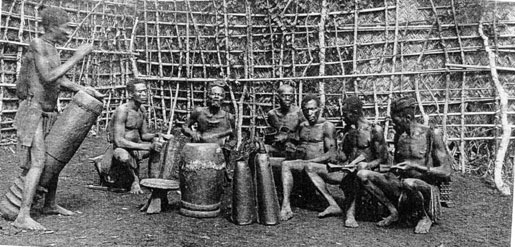
![]() Players of double bells and drum of the nyeleng society around 1925
Players of double bells and drum of the nyeleng society around 1925
The double bell kwifo, made from two tall wrought iron bells joined by a metal handle often embellished with ties, is the most sacred instrument in the Grassland. Each kingdom, like Bandjoun, has a set of five or seven, of different sounds, emitting a rhythm announcing the group or a sort of beaten language.
|
|
Daily life
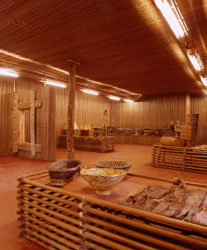 |
Countless educational principles guide the Bandjoun from childhood to maturity and to death. Some objects characterising the life cycle (birth, maturity and death) are used in everyday life and/or in different rituals: cooking utensils, adornments, costumes, fabrics, ceremonial objects etc. As life has changed over time, the plastic productions used have undergone changes. This is why some utensils have disappeared or are becoming extinct. |
|
|
[ Top page ]
| Home | The four museums | The project | Baham museum | Bandjoun museum | Mankon museum | Babungo museum |
| bandjoun@museumcam.org | Copyright 2005 C.O.E. | Powered by SYNUS |
